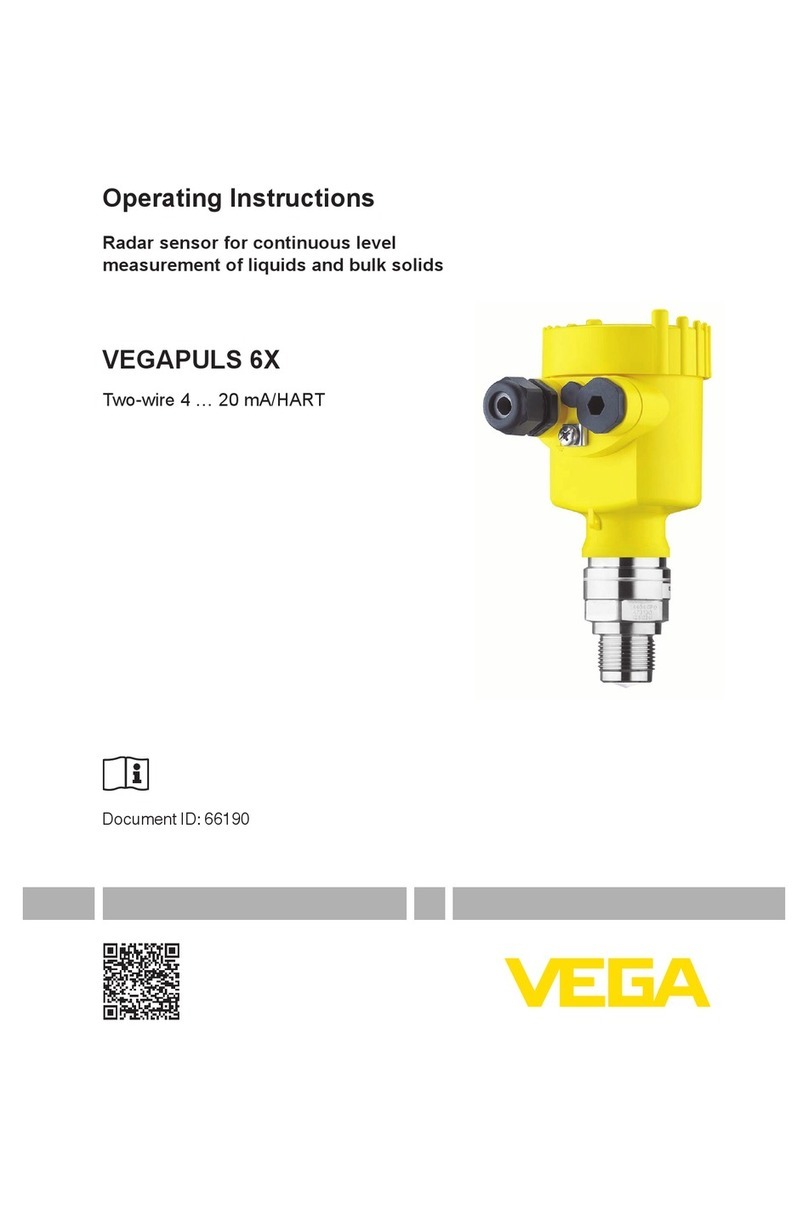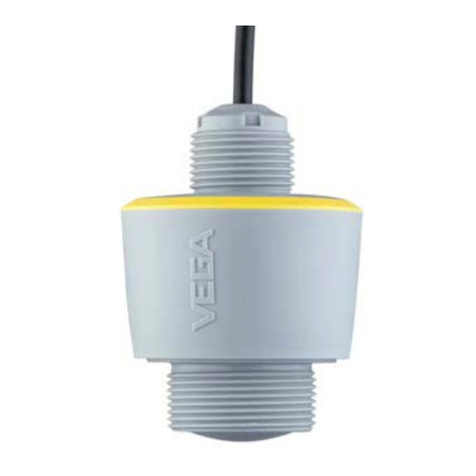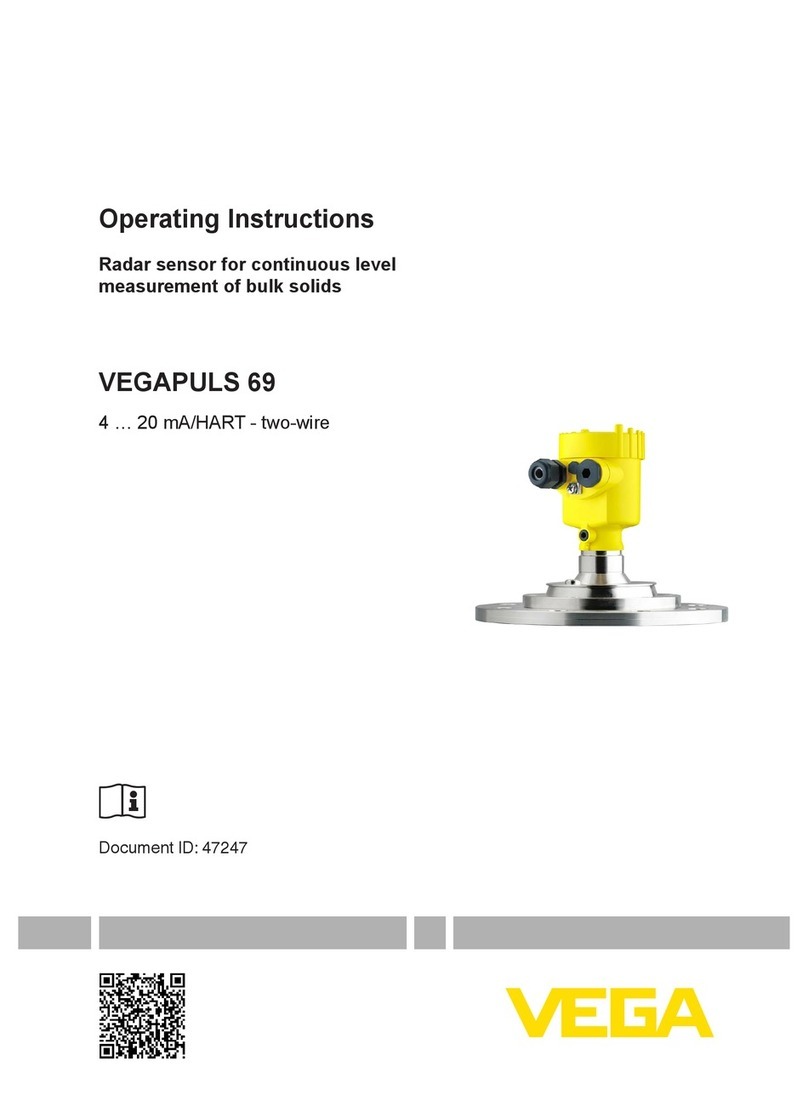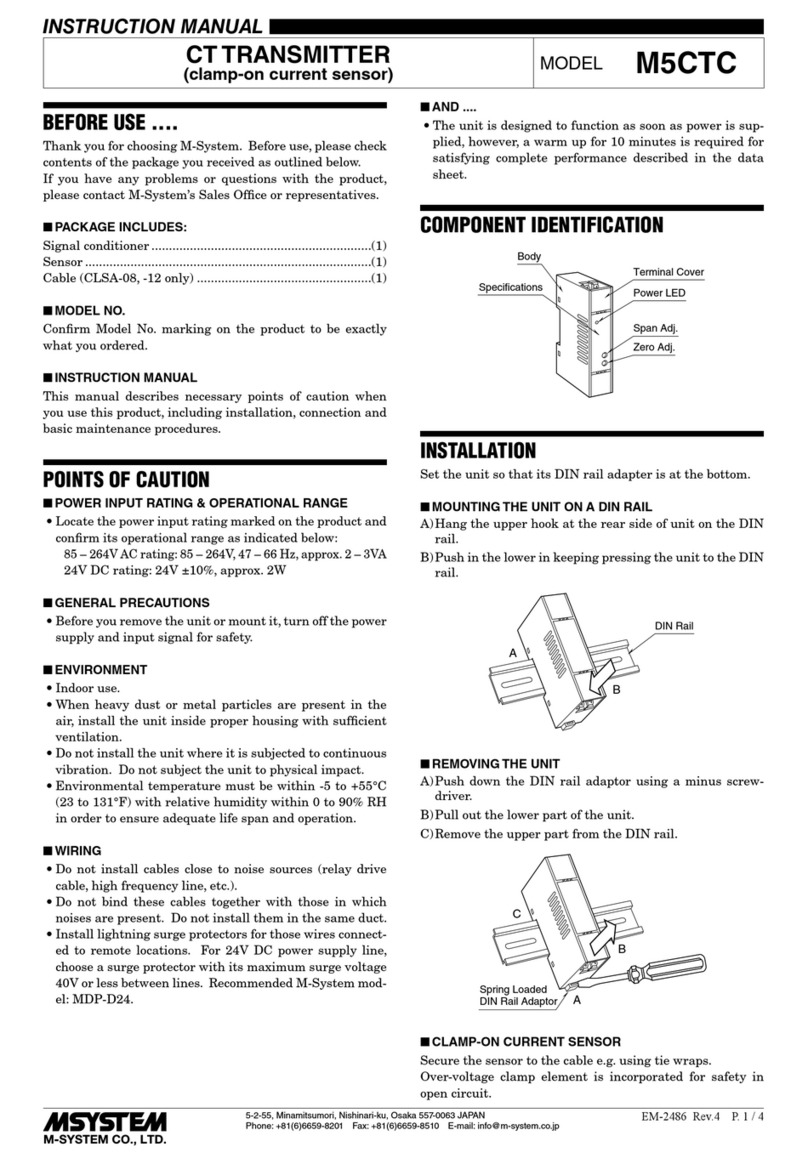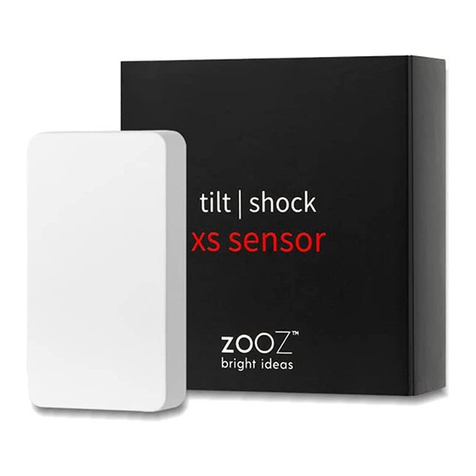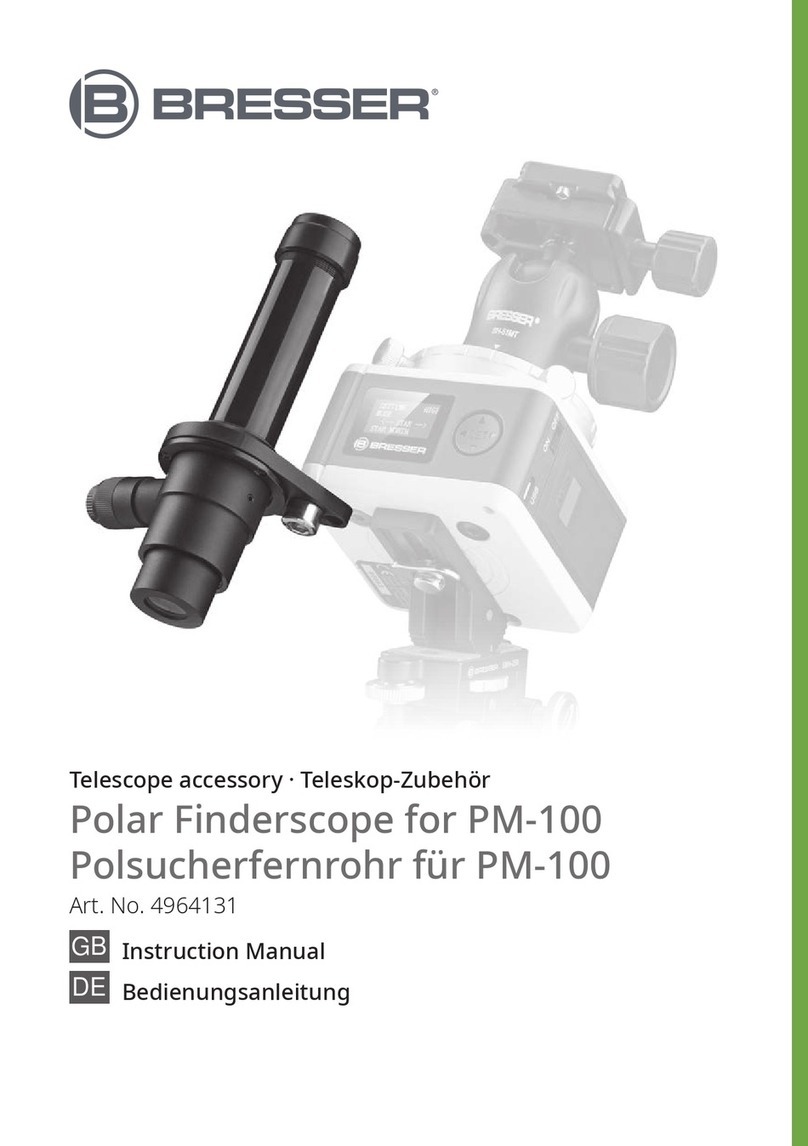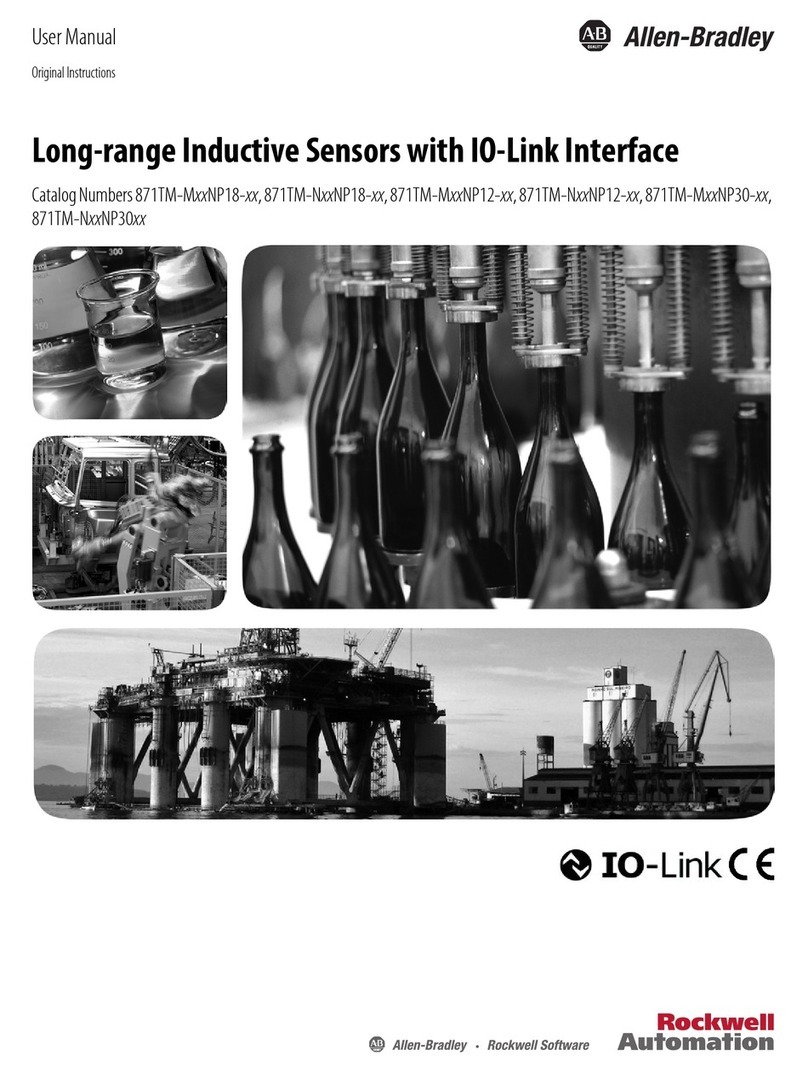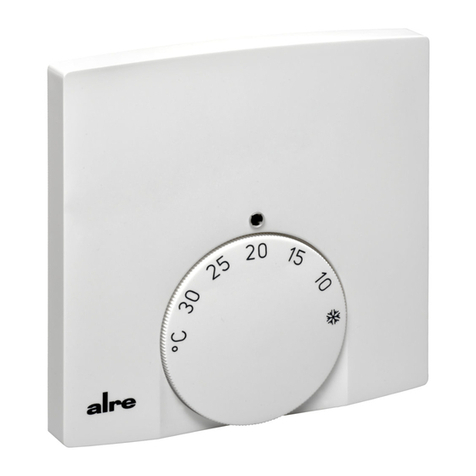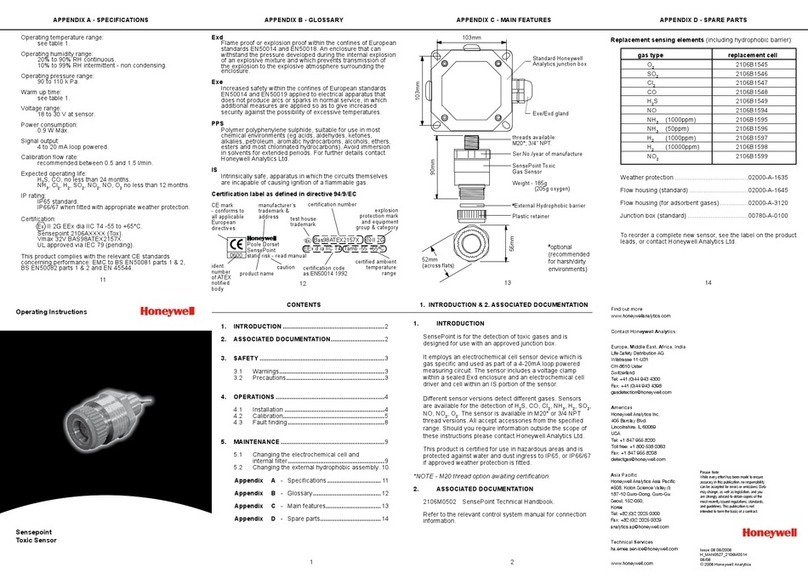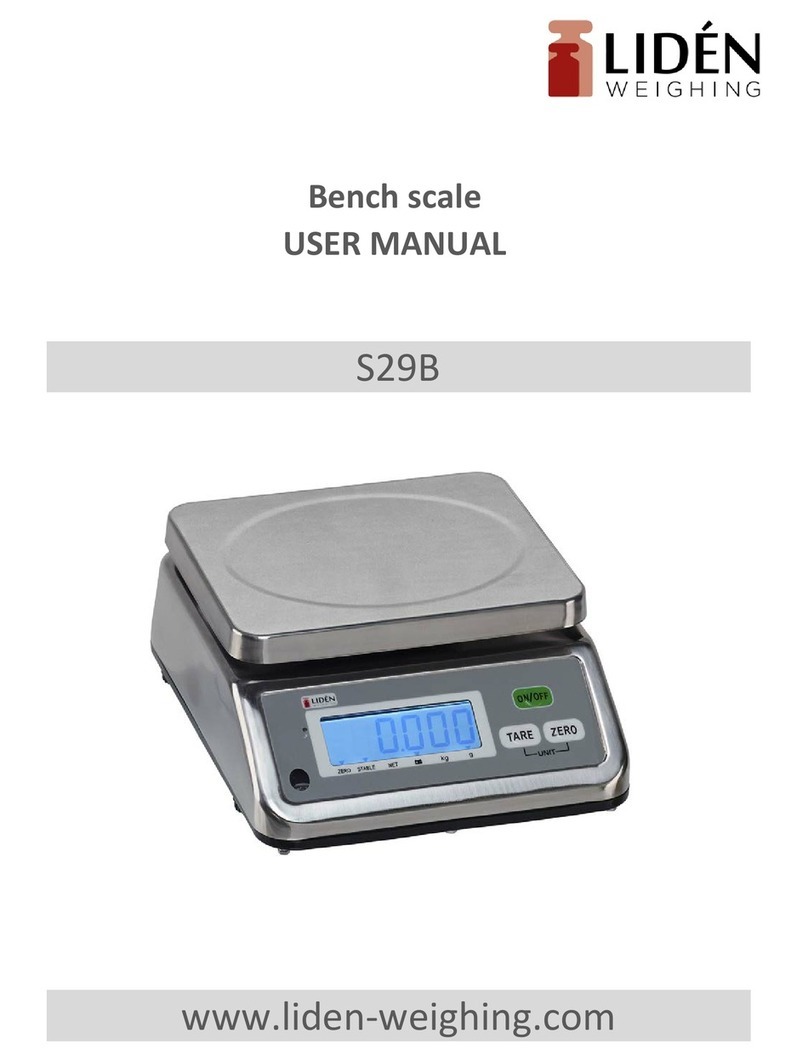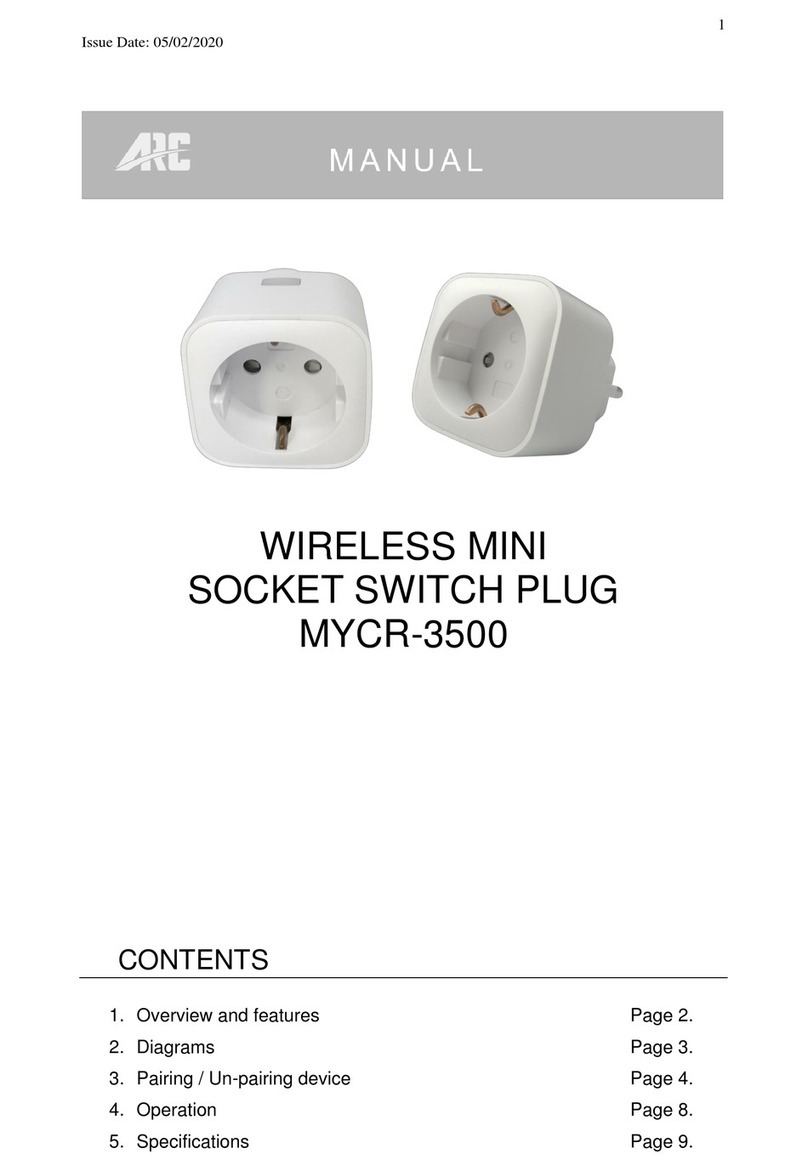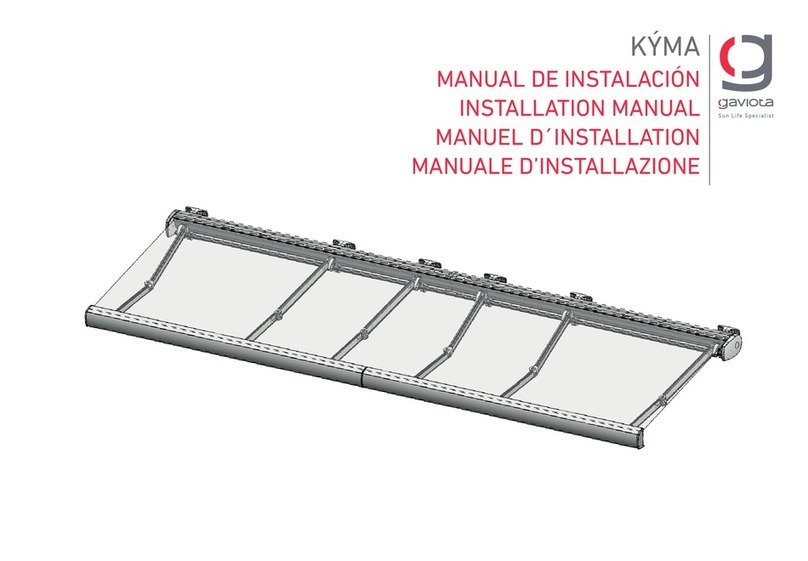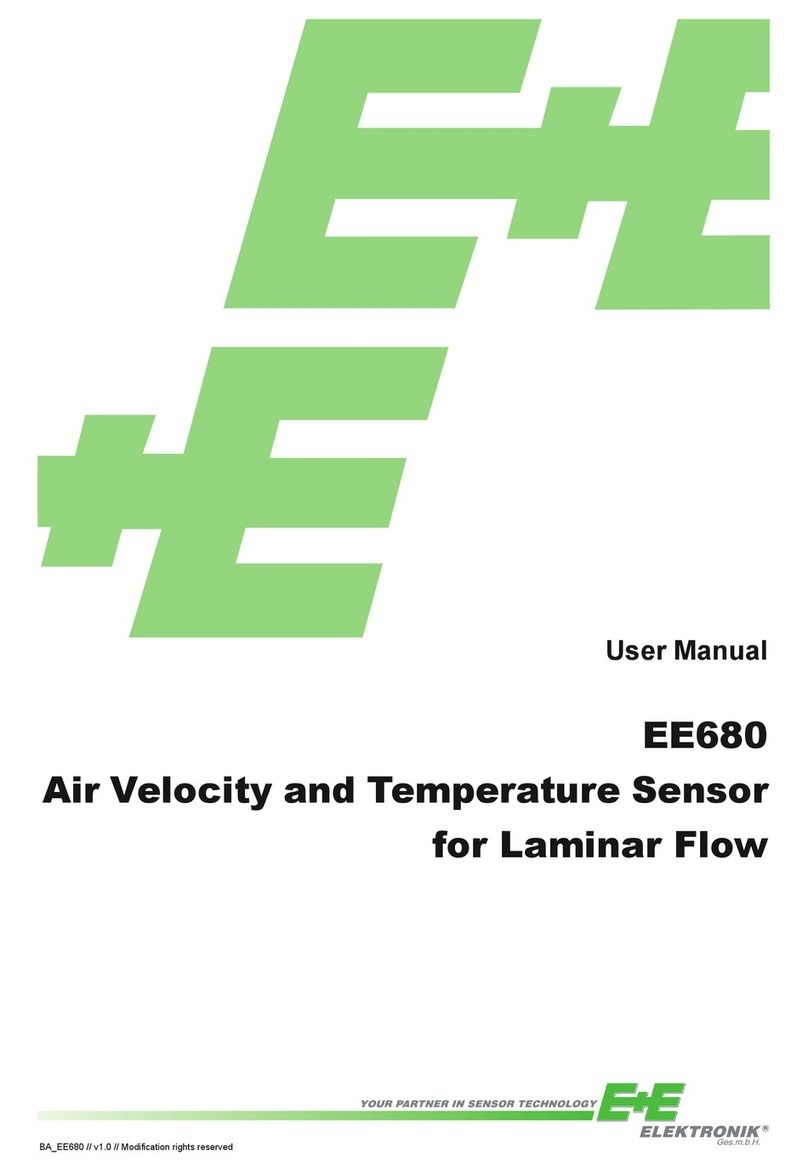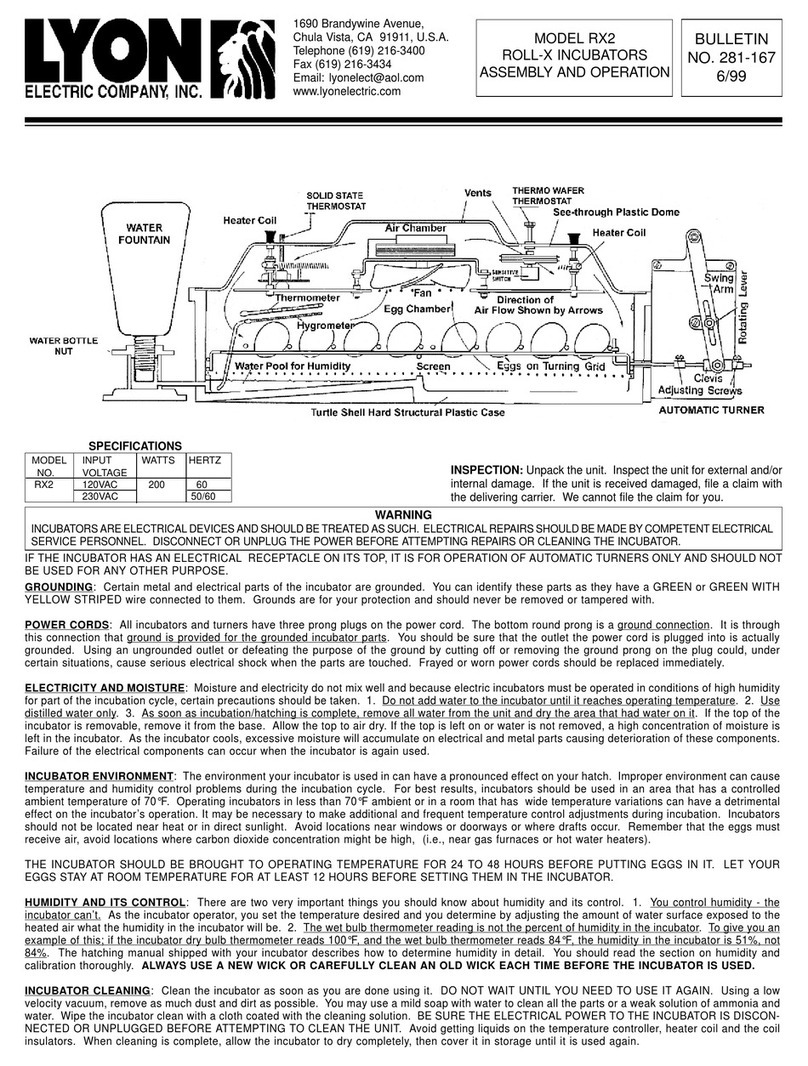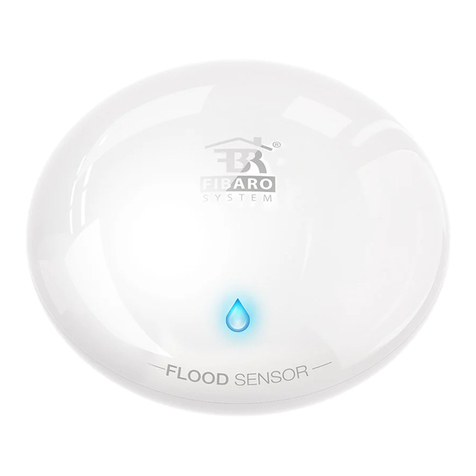Vega VEGAPULS 63 User manual

Operating Instructions
Radar sensor for continuous level
measurement of liquids
VEGAPULS 63
4 … 20 mA/HART two-wire
Document ID: 36511

2
Quick start
VEGAPULS 63 • 4 … 20 mA/HART two-wire
36511-EN-130228
Quick start
The quick start procedure enables a quick setup with many applica-
tions. You can nd further information in the respective chapters of the
operating instructions manual.
1. Distance from the vessel wall > 200 mm, the antenna should
protrude > 10 mm into the vessel
ca. 10 mm
> 200 mm
(7.87
")
Fig. 1: Distance of the antenna to the vessel wall/vessel ceiling
2. Note min. socket diameter depending on the socket length
For further information see chapter "Mounting".
1. Make sure that the power supply corresponds to the specica-
tions on the type label.
2. Connect the instrument according to the following illustration
5
12
+
( ) (-)
678
4...20mA
2
3
4
1
Fig. 2: Electronics and connection compartment, single chamber housing
1 Voltage supply, signal output
2 For display and adjustment module or interface adapter
3 For external display and adjustment unit
4 Ground terminal for connection of the cable screen
For further information see chapter "Connecting to power supply".
1. Go via the display and adjustment module to the menu "Setup".
2. In the menu item "Medium"you select the medium of your applica-
tion, for example "Aqueous solution".
3. Select in the menu item "Application" the vessel, the application
and the vessel form, for example, storage tank.
Mounting
Electrical connection
Set parameters

3
Quick start
VEGAPULS 63 • 4 … 20 mA/HART two-wire
36511-EN-130228
4. Carry out the adjustment in the menu items "Min. adjustment" and
"Max. adjustment".
The radar sensor measures the distance from the sensor to the
product surface. For indication of the real level, an allocation of the
measured distance to the percentage height must be carried out.
100%
0%
0,5 m
(19.68
")
5 m
(196.9
")
2
1
Fig. 3: Parameter adjustment example min./max. adjustment
1 Min. level = max. meas. distance
2 Max. level = min. meas. distance
For this adjustment, the distance is entered when the vessel is full
and nearly empty. If these values are not known, an adjustment with
other distances, for example, 10 % and 90 % is also possible. Starting
point for these distance specications is always the seal surface of
the thread or ange.
1. In the menu "Additional settings", menu item "Damping" you can
adjust the requested damping of the output signal.
2. Select the output characteristics in the menu item "Current out-
put".
The quick start is then nished. For further information see chapter
"Parameter adjustment".
Parameterization example
Further steps

4
Contents
VEGAPULS 63 • 4 … 20 mA/HART two-wire
36511-EN-130228
Contents
1 About this document
1.1 Function ............................................................................. 6
1.2 Target group ....................................................................... 6
1.3 Symbolism used................................................................. 6
2 For your safety
2.1 Authorised personnel ......................................................... 7
2.2 Appropriate use.................................................................. 7
2.3 Warning about incorrect use............................................... 7
2.4 General safety instructions................................................. 7
2.5 CE conformity..................................................................... 8
2.6 NAMUR recommendations ................................................ 8
2.7 Radio license for Europe .................................................... 8
2.8 Radio license for USA/Canada........................................... 8
2.9 Environmental instructions ................................................. 9
3 Product description
3.1 Conguration.................................................................... 10
3.2 Principle of operation........................................................ 11
3.3 Packaging, transport and storage..................................... 11
3.4 Accessories and replacement parts ................................. 12
4 Mounting
4.1 General instructions ......................................................... 14
4.2 Instructions for installation................................................ 14
5 Connecting to power supply
5.1 Preparing the connection ................................................. 22
5.2 Connection....................................................................... 23
5.3 Wiring plan, single chamber housing................................ 24
5.4 Wiring plan, double chamber housing .............................. 25
5.5 Wiring plan, double chamber housing Ex d ...................... 26
5.6 Wiring plan - version IP 66/IP 68 (1 bar) ........................... 27
5.7 Switch-on phase............................................................... 28
6 Set up with the display and adjustment module
6.1 Insert display and adjustment module .............................. 29
6.2 Adjustment system........................................................... 30
6.3 Parameter adjustment ...................................................... 31
6.4 Saving the parameter adjustment data............................. 44
7 Setup with PACTware
7.1 Connect the PC ................................................................ 45
7.2 Parameter adjustment with PACTware.............................. 46
7.3 Saving the parameter adjustment data............................. 47
8 Set up with other systems
8.1 DD adjustment programs ................................................. 48
8.2 Communicator 375, 475................................................... 48
9 Diagnosis, Asset Management and service
9.1 Maintenance .................................................................... 49
9.2 Measured value and event memory ................................. 49

5
Contents
VEGAPULS 63 • 4 … 20 mA/HART two-wire
36511-EN-130228
9.3 Asset Management function............................................. 50
9.4 Rectify faults..................................................................... 53
9.5 Exchanging the electronics module.................................. 57
9.6 Software update ............................................................... 57
9.7 How to proceed in case of repair...................................... 58
10 Dismounting
10.1 Dismounting steps............................................................ 59
10.2 Disposal ........................................................................... 59
11 Supplement
11.1 Technical data .................................................................. 60
11.2 Dimensions ...................................................................... 67
Safety instructions for Ex areas
Please note the Ex-specic safety information for installation and op-
eration in Ex areas. These safety instructions are part of the operating
instructions manual and come with the Ex-approved instruments.
Editing status: 2013-02-08

6
1 About this document
VEGAPULS 63 • 4 … 20 mA/HART two-wire
36511-EN-130228
1 About this document
1.1 Function
This operating instructions manual provides all the information you
need for mounting, connection and setup as well as important instruc-
tions for maintenance and fault rectication. Please read this informa-
tion before putting the instrument into operation and keep this manual
accessible in the immediate vicinity of the device.
1.2 Target group
This operating instructions manual is directed to trained specialist
personnel. The contents of this manual should be made available to
these personnel and put into practice by them.
1.3 Symbolism used
Information, tip, note
This symbol indicates helpful additional information.
Caution: If this warning is ignored, faults or malfunctions can result.
Warning: If this warning is ignored, injury to persons and/or serious
damage to the instrument can result.
Danger: If this warning is ignored, serious injury to persons and/or
destruction of the instrument can result.
Ex applications
This symbol indicates special instructions for Ex applications.
• List
The dot set in front indicates a list with no implied sequence.
→ Action
This arrow indicates a single action.
1 Sequence
Numbers set in front indicate successive steps in a procedure.
Battery disposal
This symbol indicates special information about the disposal of bat-
teries and accumulators.

7
2 For your safety
VEGAPULS 63 • 4 … 20 mA/HART two-wire
36511-EN-130228
2 For your safety
2.1 Authorised personnel
All operations described in this operating instructions manual must
be carried out only by trained specialist personnel authorised by the
plant operator.
During work on and with the device the required personal protective
equipment must always be worn.
2.2 Appropriate use
VEGAPULS 63 is a sensor for continuous level measurement.
You can nd detailed information on the application range in chapter
"Product description".
Operational reliability is ensured only if the instrument is properly
used according to the specications in the operating instructions
manual as well as possible supplementary instructions.
2.3 Warning about incorrect use
Inappropriate or incorrect use of the instrument can give rise to
application-specic hazards, e.g. vessel overll or damage to system
components through incorrect mounting or adjustment.
2.4 General safety instructions
This is a state-of-the-art instrument complying with all prevailing
regulations and guidelines. The instrument must only be operated in a
technically awless and reliable condition. The operator is responsible
for the trouble-free operation of the instrument.
During the entire duration of use, the user is obliged to determine the
compliance of the necessary occupational safety measures with the
current valid rules and regulations and also take note of new regula-
tions.
The safety instructions in this operating instructions manual, the na-
tional installation standards as well as the valid safety regulations and
accident prevention rules must be observed by the user.
For safety and warranty reasons, any invasive work on the device
beyond that described in the operating instructions manual may be
carried out only by personnel authorised by the manufacturer. Arbi-
trary conversions or modications are explicitly forbidden.
The safety approval markings and safety tips on the device must also
be observed.
Depending on the instrument version, the emitting frequencies are in
the C or K band range. The low emitting frequencies are far below the
internationally approved limit values. When used correctly, there is no
danger to health.

8
2 For your safety
VEGAPULS 63 • 4 … 20 mA/HART two-wire
36511-EN-130228
2.5 CE conformity
The device fullls the legal requirements of the applicable EC guide-
lines. By axing the CE marking, we conrm successful testing of the
product.
You can nd the conformity certicate in the download section of our
homepage.
Electromagnetic compatibility
Instruments with plastic housing as well as in four-wire or Ex-d-ia
version are designed for use in an industrial environment. Neverthe-
less, electromagnetic interference from electrical conductors and
radiated emissions must be taken into account, as is usual with a
class A instrument according to EN 61326-1. If the instrument is used
in a dierent environment, the electromagnetic compatibility to other
instruments must be ensured by suitable measures.
2.6 NAMUR recommendations
NAMUR is the automation technology user association in the process
industry in Germany. The published NAMUR recommendations are
accepted as the standard in eld instrumentation.
The device fullls the requirements of the following NAMUR recom-
mendations:
• NE 21 – Electromagnetic compatibility of equipment
• NE 43 – Signal level for malfunction information from measuring
transducers
• NE 53 – Compatibility of eld devices and display/adjustment
components
• NE 107 - Self-monitoring and diagnosis of eld devices
For further information see www.namur.de.
2.7 Radio license for Europe
The instrument is approved according to EN 302372-1/2 (2006-04)
for use in closed vessels.
2.8 Radio license for USA/Canada
The instrument is in conformity with part 15 of the FCC regulations.
Take note of the following two regulations:
• The instrument must not cause any interfering emissions
• The device must be insensitive to interfering immissions, including
those that may cause undesirable operating conditions
Modications not expressly approved by the manufacturer will lead to
expiry of the operating licence according to FCC/IC.
The instrument is in conformity with RSS-210 of the IC regulations.
The instrument may only be used in closed vessels made of metal,
concrete, or bre-reinforced plastic.

9
2 For your safety
VEGAPULS 63 • 4 … 20 mA/HART two-wire
36511-EN-130228
2.9 Environmental instructions
Protection of the environment is one of our most important duties.
That is why we have introduced an environment management system
with the goal of continuously improving company environmental pro-
tection. The environment management system is certied according
to DIN EN ISO 14001.
Please help us fulll this obligation by observing the environmental
instructions in this manual:
• Chapter "Packaging, transport and storage"
• Chapter "Disposal"

10
3 Product description
VEGAPULS 63 • 4 … 20 mA/HART two-wire
36511-EN-130228
3 Product description
3.1 Conguration
The nameplate contains the most important data for identication and
use of the instrument:
2
1
13
14
15
16
12
11
5
3
6
4
7
8
9
10
Fig. 4: Layout of the type label (example)
1 Instrument version
2 Product code
3 Approvals
4 Power supply and signal output, electronics
5 Protection rating
6 Measuring range
7 Process and ambient temperature, process pressure
8 Material, wetted parts
9 Hardware and software version
10 Order number
11 Serial number of the instrument
12 Symbol of the device protection class
13 ID numbers, instrument documentation
14 Note to observe the instrument documentation
15 NotiedauthorityforCEmarking
16 Approval directive
With the serial number of the instrument on the type label you have
access to the following data on our homepage:
• Article number of the instrument (HTML)
• Delivery date (HTML)
• Order-specic instrument features (HTML)
• Operating instructions at the time of shipment (PDF)
• Order-specic sensor data for an electronics exchange (XML)
• Test certicate "Measuring Accuracy" (PDF)
For this purpose, move to www.vega.com and "VEGA Tools".
This operating instructions manual applies to the following instrument
versions:
• Hardware version from 2.1.0
• Software version from 4.5.1
Type plate
Serial number
Scope of this operating
instructions manual

11
3 Product description
VEGAPULS 63 • 4 … 20 mA/HART two-wire
36511-EN-130228
The instrument is available in two dierent electronics versions. Each
version can be identied via the product code on the type label as
well as on the electronics.
• Standard electronics type PS60HK.-
• Electronics with increased sensitivity type PS60HS.-
The scope of delivery encompasses:
• Radar sensor
• Documentation
– this operating instructions manual
– Test certicate measuring accuracy (optional)
– Operating instructions manual "Display and adjustment mod-
ule" (optional)
– Supplementary instructions "GSM/GPRS radio module"
(optional)
– Supplementary instructions manual "Heating for display and
adjustment module" (optional)
– Supplementary instructions manual "Plug connector for con-
tinuously measuring sensors" (optional)
– Ex-specic "Safety instructions" (with Ex versions)
– if necessary, further certicates
3.2 Principle of operation
The VEGAPULS 63 is a radar sensor for continuous level measure-
ment of aggressive liquids or with hygienic requirements. It is suitable
for applications in storage tanks, process vessels, dosing vessels and
reactors.
The standard electronics enables the use of instruments in products
with an εr-Wert ≥1.8. The electronics version with increased sensitivity
enables the use of the instrument also in applications with very poor
reective properties or products with an εr value ≥1.5. The values that
can be actually reached depend on the measurement conditions, the
antenna system or the standpipe or bypass tube.
The antenna of the radar sensor emits short radar pulses with a
duration of approx. 1 ns. These pulses are reected by the product
and received by the antenna as echoes. The transit time of the radar
pulses from emission to reception is proportional to the distance and
hence to the level. The determined level is converted into an appropri-
ate output signal and outputted as measured value.
3.3 Packaging, transport and storage
Your instrument was protected by packaging during transport. Its
capacity to handle normal loads during transport is assured by a test
following ISO 4180.
The packaging of standard instruments consists of environment-
friendly, recyclable cardboard. For special versions, PE foam or PE
foil is also used. Dispose of the packaging material via specialised
recycling companies.
Versions
Scope of delivery
Application area
Functional principle
Packaging

12
3 Product description
VEGAPULS 63 • 4 … 20 mA/HART two-wire
36511-EN-130228
Transport must be carried out under consideration of the notes on the
transport packaging. Nonobservance of these instructions can cause
damage to the device.
The delivery must be checked for completeness and possible transit
damage immediately at receipt. Ascertained transit damage or con-
cealed defects must be appropriately dealt with.
Up to the time of installation, the packages must be left closed and
stored according to the orientation and storage markings on the
outside.
Unless otherwise indicated, the packages must be stored only under
the following conditions:
• Not in the open
• Dry and dust free
• Not exposed to corrosive media
• Protected against solar radiation
• Avoiding mechanical shock and vibration
• Storage and transport temperature see chapter "Supplement -
Technical data - Ambient conditions"
• Relative humidity 20 … 85 %
3.4 Accessories and replacement parts
The display and adjustment module PLICSCOM is used for measured
value indication, adjustment and diagnosis. It can be inserted into the
sensor and removed at any time.
You can nd further information in the operating instructions "Display
and adjustment module PLICSCOM" (Document-ID 27835).
The interface adapter VEGACONNECT enables the connection of
communication-capable instruments to the USB interface of a PC. For
parameter adjustment of these instruments, an adjustment software
such as PACTware with VEGA-DTM is required.
You can nd further information in the operating instructions "Interface
adapter VEGACONNECT" (Document-ID 32628).
VEGADIS 61 is an external display and adjustment unit for sensors
with single chamber housing and Ex-d double chamber housing.
It is suitable for measured value indication and adjustment of plics®
sensors and is connected to the sensor with a four-wire standard
cable up to 50 m long.
You can nd further information in the operating instructions "VE-
GADIS 61" (Document-ID 27720).
VEGADIS 62 is suitable for measured value indication and adjustment
of sensors with HART protocol. It is looped into the 4 … 20 mA/HART
signal cable.
You can nd further information in the operating instructions "VE-
GADIS 62" (Document-ID 36469).
Transport
Transport inspection
Storage
Storage and transport
temperature
Display and adjustment
module
Interface adapter
External display and
adjustment unit
External display and ad-
justment unit with HART
protocol

13
3 Product description
VEGAPULS 63 • 4 … 20 mA/HART two-wire
36511-EN-130228
The PLICSMOBILE T61 is an external GSM/GPRS radio unit for
transmission of measured values and for remote parameter adjust-
ment of plics® sensors. The adjustment is carried out via PACTware/
DTM by using the integrated USB connection.
You can nd further information in the supplementary instructions
"PLICSMOBILE T61" (Document-ID 36849).
The protective cover protects the sensor housing against soiling and
intense heat from solar radiation.
You will nd additional information in the supplementary instructions
manual "Protective cover" (Document-ID 34296).
Screwed anges are available in dierent versions according to the
following standards: DIN 2501, EN 1092-1, ANSI B 16.5, JIS B 2210-
1984, GOST 12821-80.
You can nd additional information in the supplementary instructions
manual "Flanges according to DIN-EN-ASME-JIS" (Document-ID
31088).
The electronics module VEGAPULS series 60 is a replacement part
for radar sensors of VEGAPULS series 60. There is a dierent version
available for each type of signal output.
You can nd further information in the operating instructions "Elec-
tronics module VEGAPULS series 60" (Document-ID 36801).
External radio unit
Protective cover
Flanges
Electronics module

14
4 Mounting
VEGAPULS 63 • 4 … 20 mA/HART two-wire
36511-EN-130228
4 Mounting
4.1 General instructions
With instruments with threaded process tting, suitable tools must be
applied for tightening the hexagon.
Warning:
The housing must not be used to screw the instrument in! Applying
tightening force can damage internal parts of the housing.
Use the recommended cables (see chapter "Connecting to power
supply") and tighten the cable gland.
You can give your instrument additional protection against moisture
penetration by leading the connection cable downward in front of the
cable entry. Rain and condensation water can thus drain o. This ap-
plies mainly to outdoor mounting as well as installation in areas where
high humidity is expected (e.g. through cleaning processes) or on
cooled or heated vessels.
Make sure that all parts of the instrument exposed to the process, in
particular the active measuring component, process seal and process
tting, are suitable for the existing process conditions. These include
above all the process pressure, process temperature as well as the
chemical properties of the medium.
You can nd the specications in chapter "Technical data" and on the
nameplate.
4.2 Instructions for installation
The PTFE washer of the antenna encapsulation is also the process
seal. The following must be fullled for an eective sealing:
1. Make sure the number of ange screws corresponds to the num-
ber of ange holes
2. Use disc springs to compensate the preload loss of the PTFE
washer
2
1
Fig. 5: Use of disc springs
1 Single disc spring
2 Laminated disc spring
3. Tighten screws with the necessary torque (see chapter "Technical
data")
4. Retighten screws in regular intervals depending on process pres-
sure and temperature
The emitted radar impulses of the radar sensor are electromagnetic
waves. The polarisation plane is the direction of the electrical wave
Screwing in
Moisture
Suitability for the process
conditions
Sealing to the process
Polarisation plane

15
4 Mounting
VEGAPULS 63 • 4 … 20 mA/HART two-wire
36511-EN-130228
component. By turning the instrument in the connection ange or
mounting boss, the polarisation can be used to reduce the eects of
false echoes.
The position of the polarisation plane is marked on the process tting
of the instrument.
1
Fig. 6: Position of the polarisation level
1 Marking hole
When mounting the VEGAPULS 63, keep a distance of at least
200 mm (7.874 in) to the vessel wall. If the sensor is installed in the
center of dished or round vessel tops, multiple echoes can arise.
These can, however, be suppressed by an appropriate adjustment
(see chapter "Setup").
If you cannot keep this distance you should carry out a false echo
storage before setup. This applies mainly if buildup on the vessel wall
is expected. In this case, we recommend repeating a false echo stor-
age later with existing buildup.
> 200 mm
(7.87
")
Fig. 7: Mounting of the radar sensor on round vessel tops
In vessels with conical bottom it can be advantageous to mount the
sensor in the center of the vessel, as measurement is then possible
down to the lowest point of the vessel bottom.
Installation position

16
4 Mounting
VEGAPULS 63 • 4 … 20 mA/HART two-wire
36511-EN-130228
Fig. 8: Mounting of the radar sensor on vessels with conical bottom
Do not mount the instruments in or above the lling stream. Make sure
that you detect the product surface, not the inowing product.
Fig.9:Mountingoftheradarsensorwithinowingmedium
Flush mounting
The best way to mount the sensor, also with respect to cleanability, is
ush on a block ange (ange without socket piece) or with hygienic
ttings, e.g. Neumo Biocontrol.
Mounting on socket
If the reective properties of the medium are good, you can mount
VEGAPULS 63 on a socket piece. You will nd recommended values
for socket heights in the following illustration. The socket end should
be smooth and burr-free, if possible also rounded. Then carry out a
false echo storage.
Inowingmedium
Socket

17
4 Mounting
VEGAPULS 63 • 4 … 20 mA/HART two-wire
36511-EN-130228
d
hmax.
d
50 mm/2"
80 mm/3"
100 mm/4"
150 mm/6"
100 mm
150 mm
250 mm
400 mm
hmax.
Fig. 10: Deviating socket dimensions
Align the sensor in liquids as vertical as possible to the product sur-
face to achieve an optimum measurement.
Fig. 11: Alignment in liquids
The mounting location of the radar sensor should be a place where no
other equipment or xtures cross the path of the microwave signals.
Vessel installations, such as e.g. ladders, limit switches, heating spi-
rals, struts, etc., can cause false echoes and impair the useful echo.
Make sure when planning your measuring site that the radar sensor
has a "clear view" to the measured product.
In case of existing vessel installations, a false echo storage should be
carried out during setup.
If large vessel installations such as struts or supports cause false
echoes, these can be attenuated through supplementary measures.
Small, inclined sheet metal baes above the installations scatter the
radar signals and prevent direct interfering reections.
Fig.12:Coversmoothproleswithdeectors
If there are agitators in the vessel, a false signal memory should be
carried out with the agitators in motion. This ensures that the interfer-
Sensor orientation
Vessel installations
Agitators

18
4 Mounting
VEGAPULS 63 • 4 … 20 mA/HART two-wire
36511-EN-130228
ing reections from the agitators are saved with the blades in dierent
positions.
Fig. 13: Agitators
Through the action of lling, stirring and other processes in the vessel,
compact foams that considerably damp the emitted signals may form
on the product surface.
If foams are causing measurement errors, the biggest possible radar
antennas, the electronics with increased sensitivity or low frequency
radar sensors (C band) should be used.
As an alternative, sensors with guided microwave can be used. These
are unaected by foam generation and are best suited for such ap-
plications.
When using a surge pipe in a vessel, inuences from vessel installa-
tions and turbulences can be excluded. Under these prerequisites,
the measurement of products with low dielectric values (εr value
≥ 1.6) is possible. In very adhesive products, measurement in a surge
pipe is not recommended.
Foam generation
Measurement in a surge
pipe

19
4 Mounting
VEGAPULS 63 • 4 … 20 mA/HART two-wire
36511-EN-130228
0%
100%
1
2
3
4
5
6
7
8
10
9
Fig.14:Congurationsurgepipe
1 Radar sensor
2 Marking of the polarisation direction
3 Threadorangeontheinstrument
4 Vent hole
5 Holes
6 Weld joint
7 Weldingneckange
8 Ball valve with complete opening
9 Fastening of the surge pipe
Instructions for orientation:
• Note marking of the polarisation plane on the sensor
• With threaded tting, the marking is on the hexagon, with ange
connection between the two ange holes
• All holes in the surge pipe must be in one plane with this marking
Instructions for the measurement:
• The 100 % point must be below the upper vent hole
• The 0 % point is the end of the surge pipe
• For the parameter adjustment, select "Application standpipe" and
enter the tube diameter to compensate errors due to running time
shift
• A false signal suppression with integrated sensor is recommended
but not mandatory
• The measurement through a ball valve with complete run is pos-
sible

20
4 Mounting
VEGAPULS 63 • 4 … 20 mA/HART two-wire
36511-EN-130228
Constructional requirements on the surge pipe:
• Material metal, smoother inner tube
• Preferably pultruded or straight beaded stainless steel tube
• Welded joint should be straight and lie in one axis with the holes
• Flanges are welded to the tube according to the orientation of the
polarisation level
• In case of a extension with a welding neck ange or pipe collar
as well as when a ball valve is used, the inner surfaces should be
aligned and accurately joined together
• Gap size with junctions ≤ 0.1 mm
• Do not weld through the pipe wall.The surge pipe must remain
smooth inside. Roughness and beads on the inside caused by
unintentional penetration should be removed since they cause
strong false echoes and encourage buildup
• Surge pipes must extend all the way down to the requested min.
level, as measurement is only possible within the tube
• Diameter of holes ≤ 5 mm, any number OK, on one side or com-
pletely through
• The antenna diameter of the sensor should correspond to the
inner diameter of the tube
• Diameter should be constant over the complete length
An alternative to measurement in a surge pipe is measurement in a
bypass tube outside of the vessel.
0 %
100 %
1
2
5
4
3
6
Fig.15:Congurationbypass
1 Radar sensor
2 Marking of the polarisation direction
3 Instrumentange
4 Distance sensor reference plane to upper tube connection
5 Distance of the tube connections
6 Ball valve with complete opening
Measurement in the
bypass
Other manuals for VEGAPULS 63
12
Table of contents
Other Vega Accessories manuals
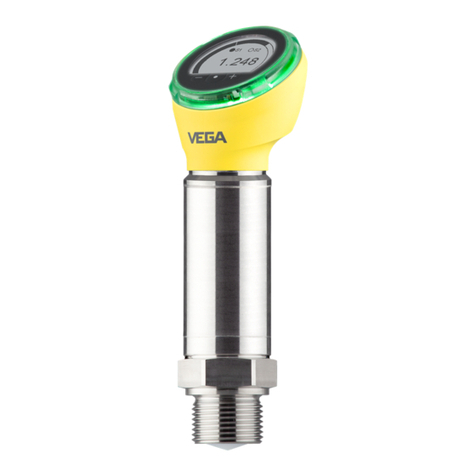
Vega
Vega VEGAPULS 42 User manual
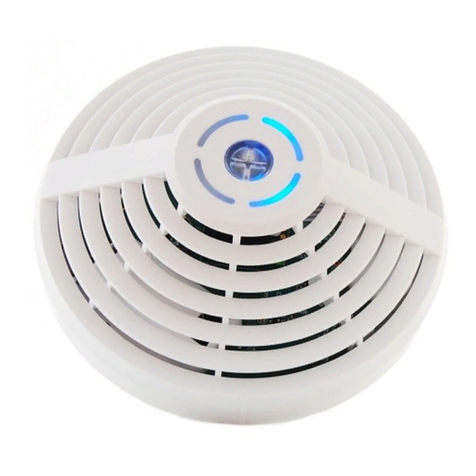
Vega
Vega SMART-SS0102 User manual

Vega
Vega VEGAPULS 63 User manual
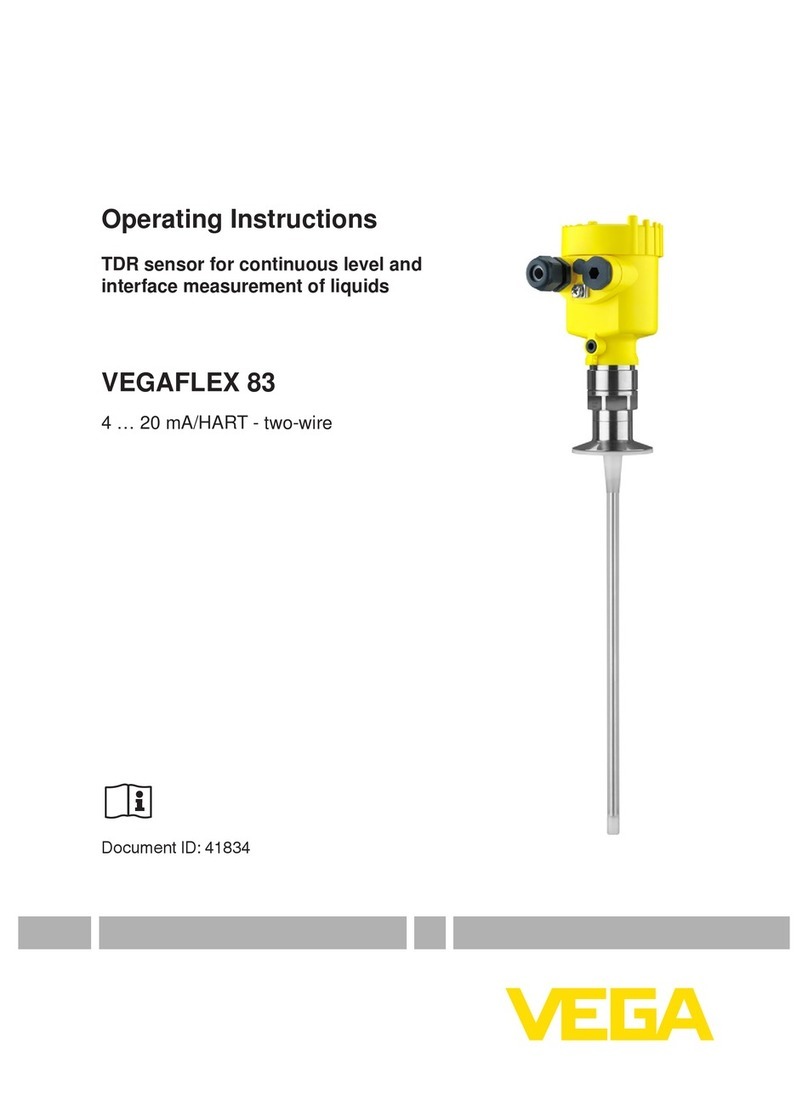
Vega
Vega vegaflex 83 User manual

Vega
Vega VEGAMET 391 User manual

Vega
Vega VEGAFLEX 65 User manual
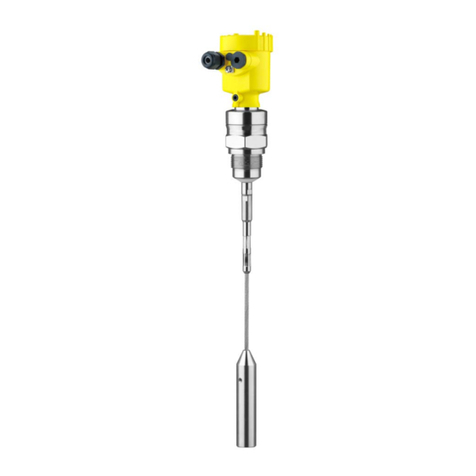
Vega
Vega VEGAFLEX 82 User manual
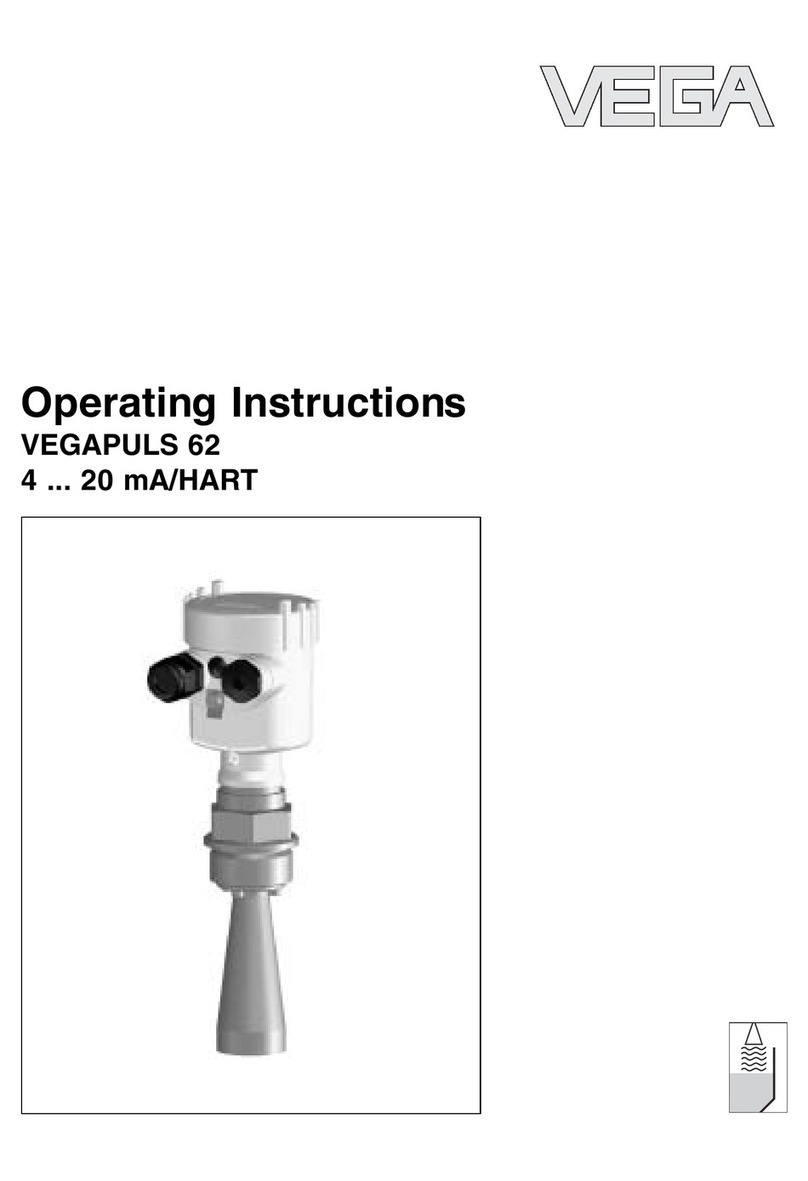
Vega
Vega VEGAPULS 62 User manual
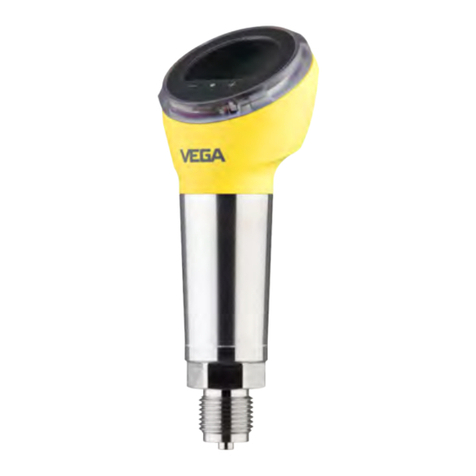
Vega
Vega VEGABAR 39 User manual

Vega
Vega VEGAPULS 63 User manual
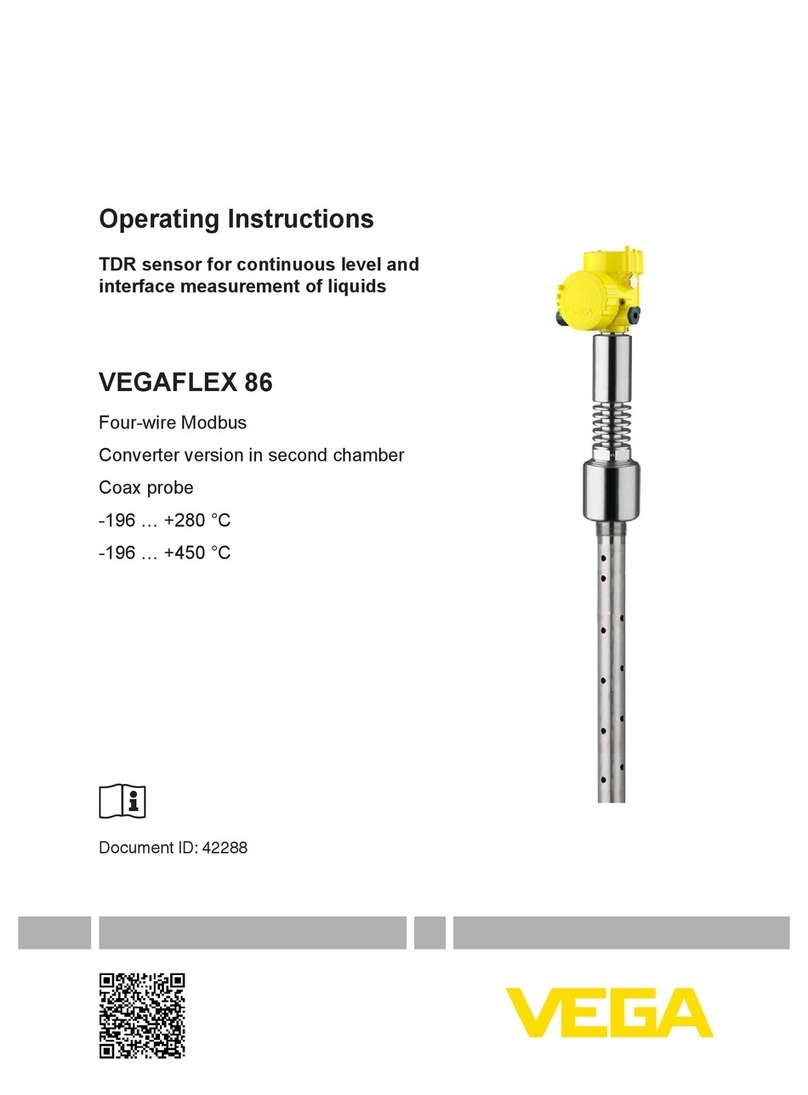
Vega
Vega VEGAFLEX 86 User manual

Vega
Vega VEGAPULS 69 User manual

Vega
Vega VEGASON 61 User manual

Vega
Vega VEGABAR 39 User manual
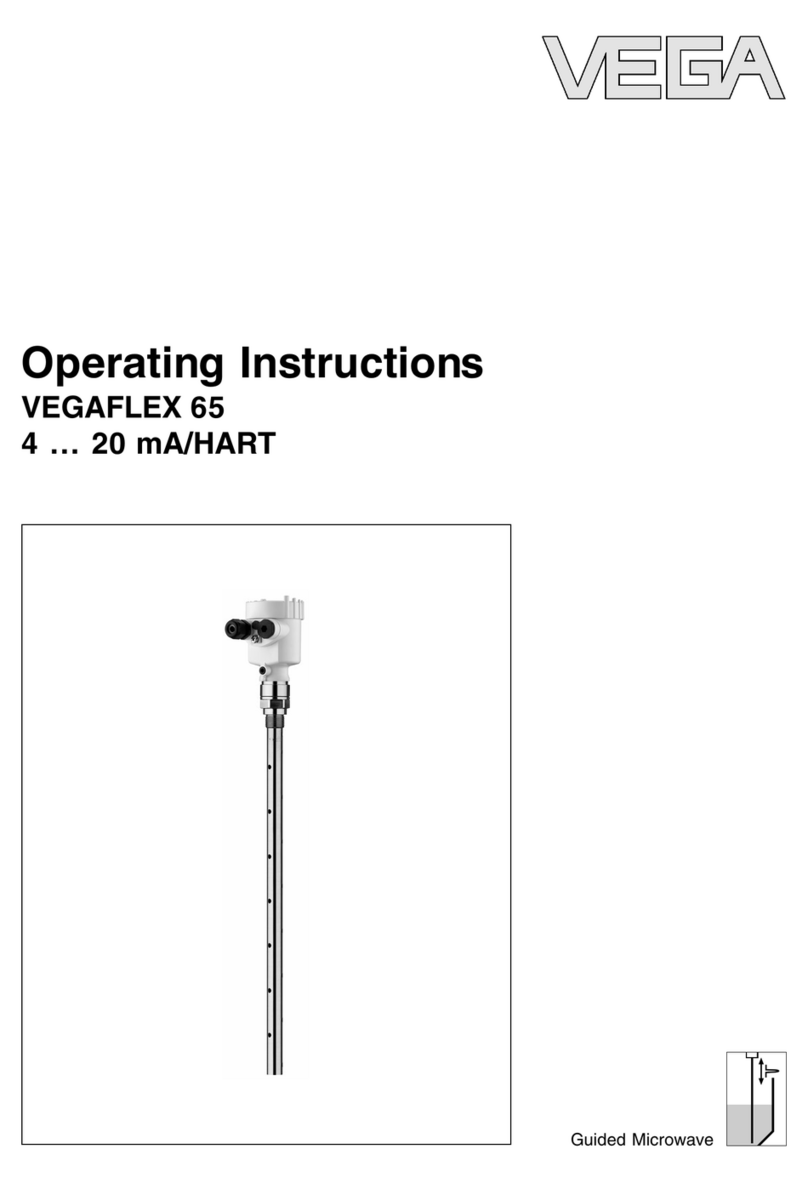
Vega
Vega VEGAFLEX 65 User manual

Vega
Vega VEGADIS 81 User manual
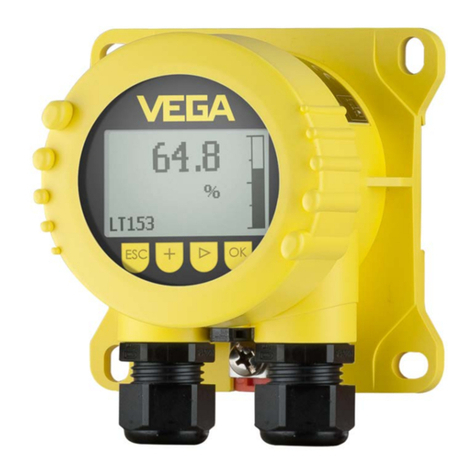
Vega
Vega VEGADIS 82 User manual
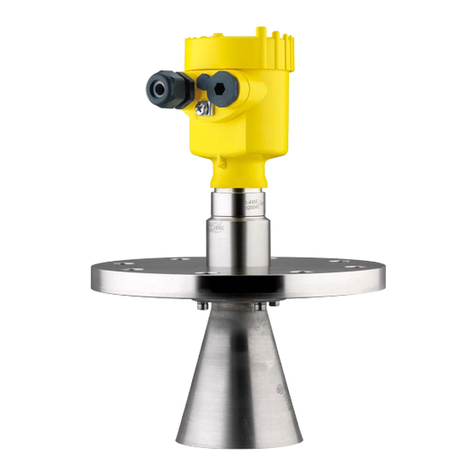
Vega
Vega VEGAPULS 66 Profibus PA User manual
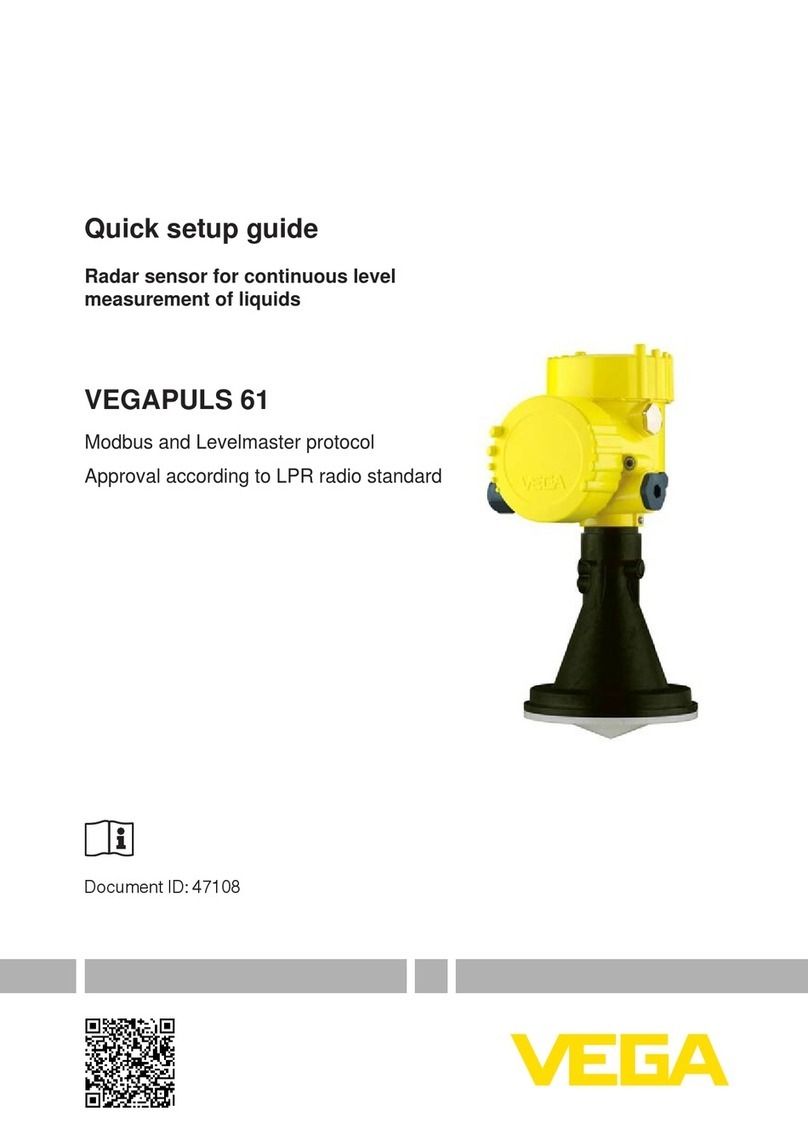
Vega
Vega VEGAPULS 61 User manual

Vega
Vega VEGADIS 61 User manual
